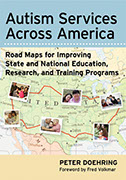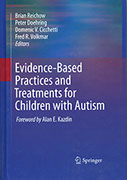Extended Services
Extended Education Services
Most public schools seek a full-time residential placement with a private provider when a family or a school finds that challenging behaviors or pervasive deficits in skills of daily life significantly impede progress at home or at school. During my tenure, DAP was the only public school program for children with ASD in the United States that also operated a quasi-residential program.
When I began my tenure, EES consisted of two 6-bedroom homes located in the community, providing primarily a traditional, full-time (24/7/365) residential program that complement the day program offered by the school. The changes to EES described below helped to keep families intact, doubled the number of slots available, decreased the likelihood of permanent and full-time placement, gave us the flexibility to implement short-term programs to address breakthrough skills and emerging needs, and increased incentives for intensive parent training.
IEP-driven services
The most significant change was the realignment of services to be driven by specified goals from the IEP (hence its new name, Extended Educational Services, or EES). I developed guidelines to help IEP teams to identify specific IEP goals for which progress was deemed inadequate, to ensure that lack of progress was not due to generally inadequate programming, and then to help the family and school to collaborate to identify and then to test other program changes that could address the skills or behaviors of concern.
This data-driven approach was instrumental to convincing IEP teams to consider more fundamental programming changes, school districts to support creative staffing solutions, and school districts and states to be more open to funding private placement in those rare cases when EES was inadequate to assure continued progress.
Staff training
I also initiated efforts to ensure that residential staff met the same training and certification requirements as their school-based counterparts, and oversaw the design and construction of a third home.
Oversight
I supervised EES with the support of an assistant principal. We led IEP-team discussions to establish the need for EES, presented the need for private placement to other state agencies, and organized programs of training to EES staff. following an inter-agency agreement between local and state education agencies.
Outcomes
Over the course of the 2007-2008 academic year, EES was used by less than 4% of DAPs student population (serving an average of 25 students on a part-time basis). This helped DAP to limit rates of in-patient hospitalization or external residential placement to less than 1% (Doehring and Winterling, 2011, 2013).
Extended Support Services
Even though respite offers a necessary and important break to caregivers of children with ASD, it is rarely available to most families. During my tenure. DAP was the only public school program for children with ASD in the United States to also offer up to 19 days of in-home respite annually to DAP students. Caregivers are responsible for a small co-pay, while providers (all school-district staff working in one of the DAP sites) were reimbursed at an hourly rate. Some DAP sites also offered in-school respite on Fridays in the summertime to supplement the Monday-Thursday summer school; this proved , which proved to be an essential support for families whose children were ineligible for traditional summer camps or after-school programs.
Reorganization and expansion
As Statewide Director, I formalized the structure, operation, and oversight of respite to make it accepted by school district staff and administrators across the state, significantly increasing access to and utilization of respite across the state. We also negotiated with insurers to resolve questions of liability when school district staff provided respite.
Oversight
I provided operational oversight of ESS. By the 2006-07 school year, respite was available to 4/6 sites (serving 90% of students statewide), and 20% of families were using respite for an average of more than 220 hours per year.
Partnerships
I had learned about a local summer sleep-away camp run by Easter Seals, Camp Fairlee Manor, from a parent in my program. I scheduled a visit to the camp, and was delighted to learn about the wide range of children they could accommodate with 1:1 staffing, and the arrangement with the Kennedy Krieger Institute for staff training. I worked with the camp to help align their 5- and 12-day sessions to cover the gaps between the regular and summer school calendars, and Fairlee Manor has been full ever since. My daughter Margot has also attended a 5 day session each of the last 8 years. The camp has continued to expand, including the addition of a zip line course which Margot has clearly enjoyed!
Related Content
On this site
 Advocates must play a central role in deciding which services should be prioritized, both for their own child and for the program as a whole
Advocates must play a central role in deciding which services should be prioritized, both for their own child and for the program as a whole
Though I believe that I always valued the unique perspective of parents, it was only with the birth of my daughter Margot that I began to fully grasp the breadth and depth of the impact of disabilities on caregivers. The most immediate and profound shift occurred with my view of extended services: I understood why some of our families were so protective of the services we had been able to extend to them, and why these services were a necessity and not a privilege. This new understanding lay behind my efforts to resolve long-standing questions and then expand extended services. From that point on, I sought parent input in every major program design initiative. This required a concerted effort to create parent advisory committees in each of the 6 programs of DAP, a statewide parent advisory group, and strong links with parent advocacy organizations statewide.
 Exercise, enjoyment, and adventure are critical elements of a healthy lifestyle for people with disabilities
Exercise, enjoyment, and adventure are critical elements of a healthy lifestyle for people with disabilities
Staff in DAPs Extended Services program were creative and adventurous in exploring activities their student's might be interested in. When I arrived at DAP, I was surprised to learn that one of the most popular outings during in-school Summer Respite was kayaking down a local stream. Later, I was surprised that students in our EES program really enjoyed regular hikes through local parks after school and on weekends. This included students with very significant intellectual disabilities or behavioral difficulties, who could be difficult to engage at school.
Staff universally reported that students seemed calmer and happier afterwards, an observation consistent with subsequent research suggesting links between vigorous exercise and lower rates of problem behaviors. This let me to build in opportunities for exercise and a variety of outings into DAP programs, into the inpatient treatment program at Foundations Behavioral Health, and in the daily schedule for my daughter Margot.
Current vita
My Presentations and Publications
 With Vince Wintering. (2013). Delaware Autism Program: Statewide Educational Services in the Public Schools. In Autism Services Across America: Roadmaps for Improving State and National Education, Research, and Training Programs. Paul H. Brookes Publishing Co., Baltimore, MD
With Vince Wintering. (2013). Delaware Autism Program: Statewide Educational Services in the Public Schools. In Autism Services Across America: Roadmaps for Improving State and National Education, Research, and Training Programs. Paul H. Brookes Publishing Co., Baltimore, MD
 With Vince Wintering. (2011). The Implementation of Evidence-Based Practices in the Public Schools. In Evidence-Based Practices and Treatments for Children with Autism. (2011). Springer-Verlaug, New York, NY.
With Vince Wintering. (2011). The Implementation of Evidence-Based Practices in the Public Schools. In Evidence-Based Practices and Treatments for Children with Autism. (2011). Springer-Verlaug, New York, NY.
 (2008). A model for regional training and service delivery for children with autism. International Society for Autism Research. London, UK.
(2008). A model for regional training and service delivery for children with autism. International Society for Autism Research. London, UK.
X